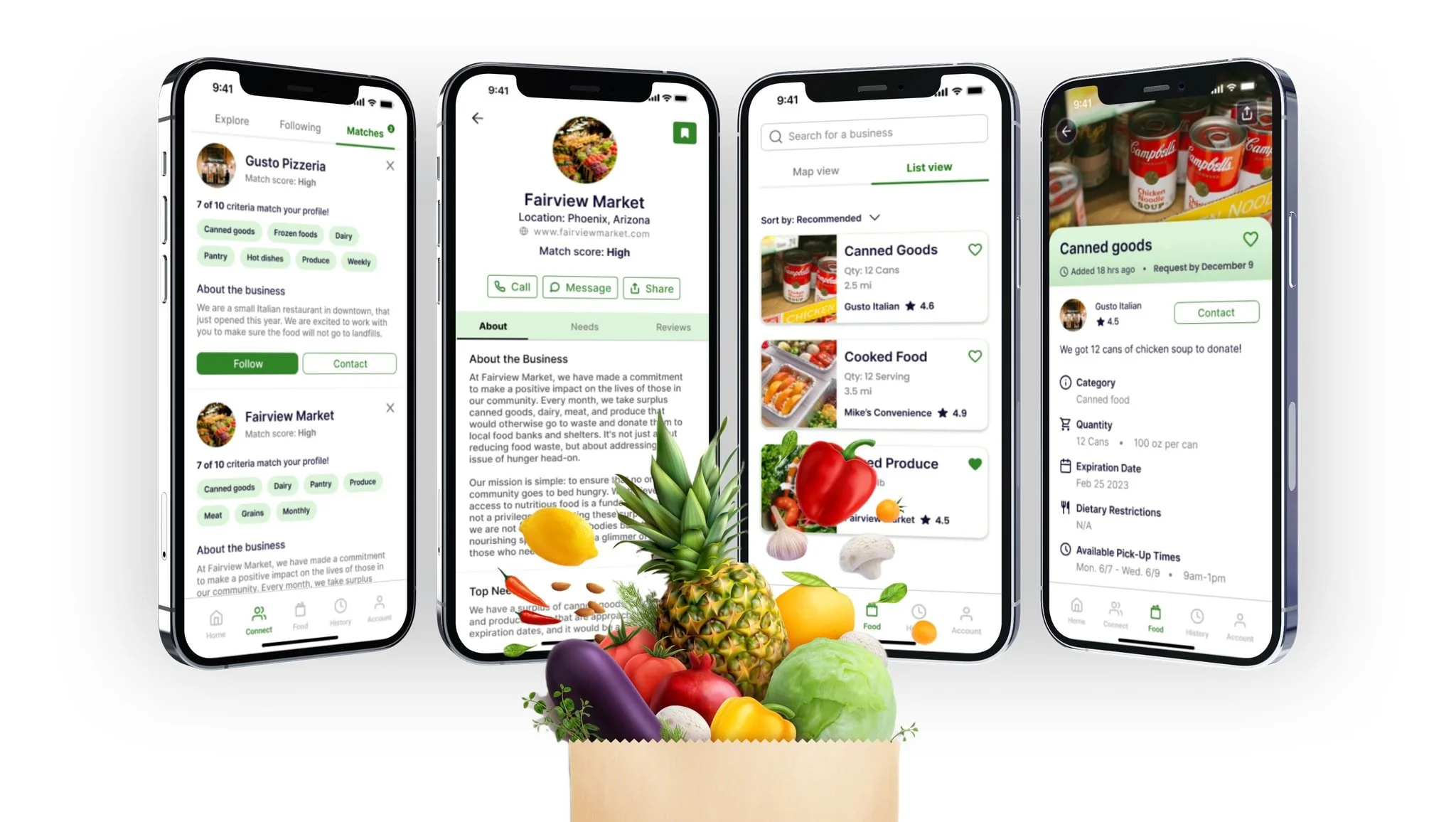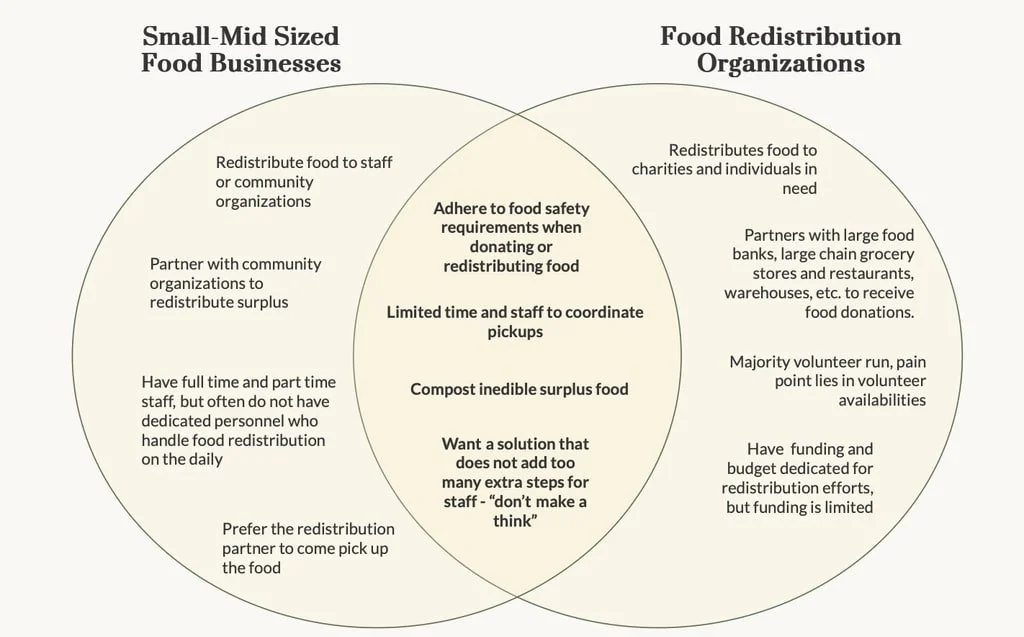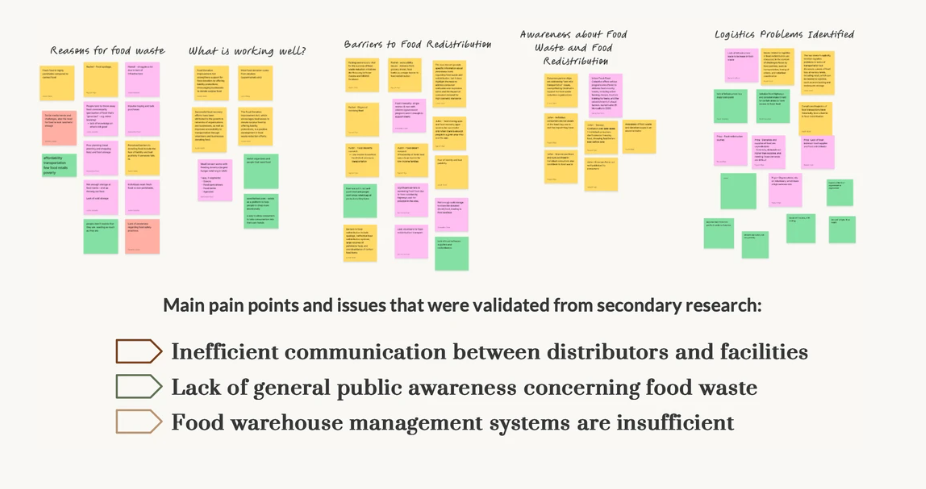An mvp that helps organizations work together to reduce food waste
How we pivoted from individual food sharing app to a business and non-profit.
Role
Apprentice UX Researcher
Team
A total of 4 teams, each team has 2 leads & 4 apprentices:
Product Managers
Product Strategists
UX Researchers
UX Designers
*Dev team will join in on later phases.
Timeline
8 weeks
Tools
Figam
Miro
Apollo
Zoom
Background
Back in 2023, I joined Tech Fleet, an organization that connects creatives with projects submitted by non-profits, to gain hands-on experience working on industry projects. With Food Distro, I was in charge of the user interviews: scheduling, organizing, and collecting & analyzing data. Our team also evenly split the tasks of secondary research, interview recruitment, drafting interview questions, and presenting our findings to our stakeholders.
Challenge
Starting Phase 2 of this project, we had a lot of questions that needed answering, namely:
What sector generates the most food waste?
Which step along the food chain can we feasibly tackle?
What are the pain points/limiting steps in their current process?
Results
With the completion of Phase 2, we found that:
81% of unsold food & beverages are not redistributed
Inefficient communication between donors & distributors are a main pain point hindering redistribution
Retailers & redistributors want a solution that doesn't add too many extra steps for staff
Snapshot Overview of High Level Findings
Challenges from the start: Hurdles to overcome
New Client, New Goals
Open source platform: Create a tool that can be used by any organization, community, or individual nationwide (USA for now) to start their food redistribution project.
Legal Research: Investigate the legal landscape of food redistribution in America.
User-friendly application: Develop a mobile & desktop-friendly application with the aim to implement AI features in the future.
Geographical Target: Focus on the USA.
Key Deliverable: Produce a prototype for user testing in next phase.
Shift in product vision: C2C to B2B
Although the original goal of this project hasn't changed, a few fundamental aspects have changed for this phase, such as the pivot from a mobile C2C platform to a B2B platform.
The reason for this change? There's been a change in Client, accompanied by a different set of expectations.
In Phase 1, we created a mobile C2C app, similar to the popular Too Good To Go model, but with individuals who donate food and individuals who take the food.
In Phase 2, we will be focussing on creating an open source B2B platform that can be used by any organization to combat food waste.
Phase 2 Objectives: UXR edition
WHERE is the problem?
Who are we helping?
How do we solve it?
Establishing a baseline: Questions to answer
Food waste was a huge monster to tackle and with so many factors, players, and laws involved in food waste a food redistribution, there was a lot to cover.
With so many questions, we struggled with narrowing down the scope of the research and scope creep was a real issue. We only had 8 weeks and time was ticking.
In the end, we turned to our research to guide our way through this hurdle. Using secondary research as our starting point, we narrowed our focus down on addressing 4 main questions:
Diving in, here are some notable pieces of data that we've found, with supporting visualizations:
49% of food wasted in America is generated by food related businesses
81% of unsold retail food & beverages are not rescued for redistribution
"The greatest opportunities lie in improving value chain communication and coordination"
Major Findings: Top 3 Food Redistribution Barriers
Baseline Established: Now what?
Using secondary research as our starting point, we narrowed our focus down on addressing 4 main questions:
Cross-team check-in: Adjusting trajectory
Armed with our newfound baseline, we had a check-in meeting with the rest of the teams (Product, Strategy, & Design) and conveyed our findings.
Here's a breakdown of the process, outcomes, and shift in product strategy:
Straight to the source: User interviews
To answer that final question (#4: What practices are working well & what are their challenges?), we needed to interview real people to truly get to the root of the issue.
Our team established the main research questions for both perspectives (donor & distributor) as well as the user criteria for interview recruitment, shown below:
Research Questions:
What are the current processes of managing food waste and redistribution at non-profit organizations & businesses?
What challenges are faced regarding food waste and food redistribution?
User Criteria
Country of residence: US
Organization type:
Non-profit organizations in food redistribution including food banks, food pantries, etc..
Roles: Coordinators, logistics managers, catering staff, and decision makers
Food businesses including restaurants, cafes, catering companies, et
Roles: Managers, owners, chefs, baristas, and servers
My role in all of this
Drafted and revised interview questions
Used Apollo to pull company emails from food businesses and non-profit food redistributors on LinkedIn and sent outreach emails
Drafted consent forms and uploaded templates to Docusign for ease of signing, ensuring privacy and consent
Organized and coordinated user interviews via Calendly and created spreadsheets to track outreach efforst
took detailed notes during interviews and summarized key points for the team, maintaining privacy and anonymity
Analyzed interview repsonses and coded them for high-level insights
Presented key research findings & next steps to stakeholders
My role in this phase of the project mainly revolved around the user interviews:
Major roadblock: Interview recruitment
Right when things were about to pick up, we ran into a major issue: the lack of interview participants. Despite our outreach efforts, we struggled with recruitment, cancellations, and no-shows.
Putting it all together: Interview insights
For a detailed breakdown of all insights — high, mid, and low level— please visit our Google Slides presentation.
From Research to Design
Our research unearthed critical insights that directly shaped the design decisions for the platform.
By understanding the needs and challenges faced by food businesses and redistribution organizations, we proposed features that address these pain points. Here's how our research translated into actionable design improvements:
Donor - Facing Solutions
Finding New Partnerships
Challenge: Food businesses find it challenging to establish new partnerships due to time constraints and the need for proactive outreach.
Suggested Solution(s):
Reduce the need for proactive outreach by implementing filtering options.
Location Filtering: Design a feature that displays nearby redistribution partners within a specified distance.
Food Category Filtering: Allow businesses to match with partners based on specific food supply and demand categories.
3. Ensuring Consistency with Non-Profit Partners
Challenge: Food quality is time-sensitive. Missed pickups lead to spoilage, resulting in businesses being hesitant to donate again.
Suggested Solution(s):
Improve communication and establish clear policies to ensure consistency.
Pickup Alerts: Send automated reminders to users about pickup times to avoid missed pickups.
No-Show Policy: Establish a strict no-show policy where cancellations are not allowed within one hour of the scheduled pickup time.
Profile Signals: Introduce profile icons indicating whether a business is looking for a redistribution partner and vice versa.
Scheduled Pickup Time Frames: Choose from predefined pickup time frames to ensure timely coordination.
Simplified Communication: Add speed dial options or per-drafted messages to streamline communication between businesses and redistribution partners.
2. Meeting Specific Donation Requirements
Challenge: Donations often need to meet strict criteria to be accepted, which can lead to rejections and additional communication back and forth.
Suggested Solution(s):
Ensure organizations clearly display their donation criteria.
Donation Criteria Display: Organizations can list their specific requirements for donations (e.g., food type, packaging standards, quality) to ensure alignment with food donors.
Standardized Check Procedure: Implement a standardized procedure to verify that redistribution organizations meet all necessary requirements before being matched with food businesses.
Non-Profit Distributor-Facing Solutions
Increasing Community Partnerships & Donations
Challenge: The amount of food donated has decreased, forcing food banks to purchase food to meet demand.
Suggested Solution(s):
Foster connections between non-profits and local businesses to increase food donations.
Partnership Connection Feature: Develop a feature that connects non-profits/food banks with local businesses that have surplus food to donate.
Motivational Appeals: Incorporate messages and incentives that appeal to businesses’ motivations to donate more food, such as highlighting social impact and community benefits.
2. Ensuring Donated Food Meets Specific Requirements
Challenge: Donated food must comply with varying food safety laws and organizational capacities.
Suggested Solution(s):
Provide clear guidelines for donation requirements.
Donation Criteria Display: Similar to the solution for food businesses, include a feature for organizations to display their specific donation criteria. (e.g., food type, quantity, quality, packaging standards).
At the end of the day, it's still a business
How could our platform impact businesses, you ask? Here are a few key benefits businesses can reap from using our application when it comes to food redistribution. (Hover over each image to read more)
Enhance Brand Image
Actively participating in food redistribution initiatives & showing commitment to sustainability and social good often leads to improved public opinion & increased sales.
Customer Loyalty
Businesses that demonstrate ethical practices often develop a positive brand image and increased trust. This can lead to repeat customers and higher customer retention rates.
Risk Mitigation
By partnering with non-profits for redistribution, businesses are protected by the Good Samaritan Act, mitigating the risks associated with donating food.
Reaching the finish line
At the end of our 8-week sprint, it was time to look back and evaluate whether we've successfully achieved our goal for Sprint 2 and met our Client's expectations.
Though we were unable to meet the open-source platform goal for this phase, it will be addressed in the next phases, once development begins.
Reflections & lessons learned
Navigating Open-Ended Requests:
Working on a project with such an open-ended request required me to constantly iterate and adapt our approach, pushing me to think creatively and strategically.
I learned the importance of defining clear objectives early on and maintaining flexibility to adjust our plans as new information emerged.
Managing Constraints:
Managing multiple project constraints, including time, resources, and scope, was another significant challenge.
I was able to navigate these constraints by prioritizing tasks, setting realistic goals, and maintaining open communication within our team.
This experience really opened my eyes to the immense value product managers bring and how hard it can be to stay focused and agile in the face of limitations.
Impact of Cross-Functional Collaboration:
Collaborating with a cross-functional team in an agile setting had a profound impact on our productivity.
The frequent check-ins, workshops, and collaborative problem-solving sessions enhanced our ability to stay aligned and respond quickly to changes.
This supportive environment helped me foster a deeper understanding and appreciation of each team member's expertise and contributions.
What's in store for the future?
In Phase 3, we'll build on what we've achieved so far:
We'll focus on testing the platform through usability testing and continuing gathering feedback.
This is crucial to validating our design decisions & ensuring the platform meets the needs of both target user groups.
We will also further explore the platform's technical feasibility and scalability, laying the groundwork for broader implementation across various organizations nationwide.
—
Outside of the project, I'll keep working on the designs to make them even better. This ongoing effort will be shown in Part 2 on my portfolio, where I'll share these updated designs (coming soon).




















